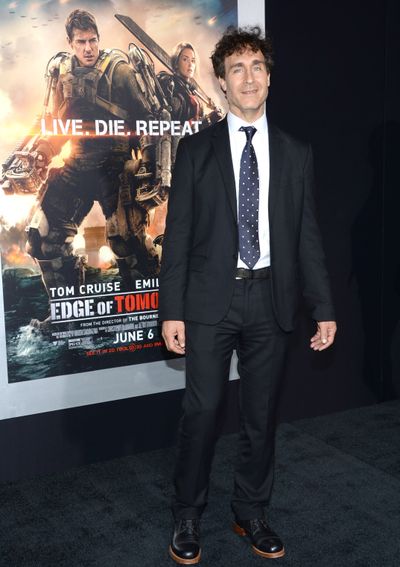Director knows how to push for results
Liman’s reputation creates enemies, respect

LOS ANGELES – In the phantasmagorial sci-fi epic “Edge of Tomorrow,” Tom Cruise finds himself encased in an 85-pound metal exoskeleton bristling with futuristic weaponry and confronted with a singularly intractable situation: a kill-and-be-killed conflict that repeats on indefinite loop.
Over and over he wages the same battle against marauding space invaders only to perish and discover himself mysteriously reincarnated, possessing terrible new knowledge of his enemy and his own limitations as a hero.
“Live, die, repeat,” as the movie’s tag line goes.
Cruise’s predicament in the film, which hits theaters today, provides a nifty parallel for the career of Doug Liman, “Edge of Tomorrow’s” trailblazing yet bedeviling director. Over the last two decades, the filmmaker has condemned himself to a cycle of creative conflict he readily acknowledges follows a certain pattern, in the process alienating friends and creating powerful Hollywood enemies. On his most notorious movie productions, the director’s M.O. – dubbed “Limania” by some former collaborators – has stretched producers and studio heads to their breaking points and imperiled his ability to get work directing movies.
“It’s no secret that my process is a little bit loose and can be a little bit infuriating to a studio if they don’t know what they’re signing up for,” Liman says, letting his understatement hang in the air of his West Los Angeles production office.
All the while, however, the Manhattan-born Liman has continued to burnish a filmography distinguished by features that have become touchstones of their respective genres. Among them: 1996’s lounge-lizard dramedy “Swingers,” responsible for launching the careers of Vince Vaughn and Jon Favreau and injecting the phrase “You’re so money” into popular consciousness; “The Bourne Identity,” which grafted existential turmoil onto a Robert Ludlum spy thriller in 2002, and “Mr. & Mrs. Smith,” the romantic-action-comedy that first unleashed the entity known as Brangelina on the world in 2005.
“Edge of Tomorrow” appears set to follow in that line, boasting an impressive 92 percent “freshness” rating on the movie review aggregator RottenTomatoes.com and showing strong pre-release awareness across the globe for showcasing action veteran Cruise in a totally new light.
“It’s fun coming up with new ways to kill yourself,” Cruise says with a laugh. “I told the stunt guys, ‘Watch Wile E. Coyote cartoons. It’s not violent enough!’ ”
Moreover, Liman’s eclectic oeuvre goes some way to explaining why he chooses to view his latest effort – a $178-million popcorn movie that makes extensive use of green-screen technology and stars the most enduring action hero in moviedom – as an “independent film.” Even if that process of maintaining creative autonomy results in ruffling Hollywood’s feathers again and again.
“I never want to repeat myself,” Liman, 48, says of his body of work. “I can’t imagine anything else as upsetting as realizing I’m redoing something I did before. For some reason, when it comes to film, I’m very good at not repeating myself. Even though in the rest of my life, I’m constantly repeating my mistakes.”
Developed into a screenplay by 3 Arts Entertainment, Liman joined the project in 2010, with Cruise signing on a year later. About six months before cameras rolled in 2012, the Limania began in earnest.
With the movie’s coveted June release date staked out by its distributor Warner Bros. and a hefty nine-figure budget on the line, Liman says he discarded more than two-thirds of Dante Harper’s original script to rebuild the movie “from scratch.” A mere eight weeks before physical production began on “Edge of Tomorrow,” the film was still without a final act that Liman found satisfactory.
As producers and studio bosses gnashed their teeth, the situation resulted in a testy exchange among Liman, Cruise and Emily Blunt, who co-stars as legendary commando Rita Vrataski – a character known as “full-metal bitch” for having killed 1,000 mimics in a single battle – who mentors Cruise’s reluctant hero.
“I was a little under pressure and I snapped,” Liman recalls. “And Emily said, ‘Easy, I’ve never made a movie like this before!’ I fired back, ‘Well, neither have I!’ ”
“The room sort of ground to a halt,” the director continues. “My producer Erwin Stoff told me later it was the most incredible thing he’d ever heard anyone say: The director telling the stars of the movie that, basically, he had no idea what he was doing.”
Cruise was aware of the director’s reputation but insists he was in no way thrown by Liman’s flying- by-the-seat-of-his-pants admission.
“It didn’t faze me at all,” Cruise says. “Good. Whatever. There’s no doubt about this guy’s talent, no doubt about his taste and his commitment. And one of the ways Doug works, you’re developing the tone as you’re working.”
“Having produced so many films and worked with so many people, I admire and appreciate that Doug is that honest,” Cruise continues. “You can actually have real conversations. What I love about Doug is his relentless pursuit of making the best movie he can make.”
Blunt puts a finer point on that character trait.
“He has no filter when it comes to being honest,” she says. “You can waste so much time with politeness and diplomacy on set. That’s what’s so refreshing about Doug. He’s honest when he’s not happy with something and very honest when he is happy with something. He’s confident enough to try anything and carve out new space for every moment that is in the movie.”